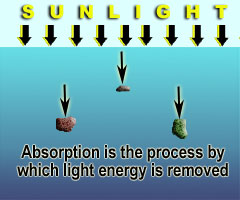|
|
|
|
|
 |
|
|
You may have heard of
"toxic 'Red Tides'" but not all Harmful Algal Blooms
(HABs) are red... and not all "Red Tides" are harmful!
What causes distinct coloration of water associated with HABs?
It is natural to assume that the colors come from the phytoplankton
themselves (e.g., that the algae are red in color) but that's
not really the case. There are several possible reasons for the
discolorations including the combined optical properties of all
components in the water (not just the algae) and the depth distribution
of the bloom.
|
|
|
 |
|
|
|
|
|
|
Particles of light (i.e., photons)
may be either scattered (path of light energy changes direction)
or absorbed (light energy is removed). These processes determine
the fate of light entering the ocean and thus ocean color. Different
constituents (e.g., particles) found in the ocean absorb and scatter
light differently; it is the sum of scattering and absorption
by all these constituents that impart ocean color. (For
more on optics, see the Smithsonian
Environmental Research Center's "What is hydrologic optics?"
website.)
|
|
|
|
|
|
|
|
 |
|
|
|
To the eye, ocean color
is the ratio of backscattering to absorption. Water
itself both backscatters and absorbs light in a distinctive way;
likewise, all the "stuff" in water has its own characteristic
backscattering and absorption. Roll your cursor over the buttons
below to see how backscattering, absorption, and ocean color vary
in several conditions: clear water, water with very small phytoplankton,
water with large/varied size phytoplankton, and blooms.
|
|
|
|
|
|
|
|
|
|
|
|
In addition to backscattering
and absorption, other factors can also influence ocean color, especially
in bloom conditions. By rolling your cursor over "Bloom conditions"
(above) you'll see that blooms of small cells have low red backscatter;
from this you'd expect that so-called "Red Tides" cannot
be produced by small cells. However, red reflection CAN be produced
when small cells concentrate near the surface to form an optically
shallow ocean layer. Under these conditions, the shallow
layer of phytoplankton prevents light from penetrating deep enough
for water to absorb all the red photons. Roll your cursor over "Clear
water" (above): note that the strong red absorption applies
to the "deep blue sea." (Divers know that blood
appears black at depth and red near the surface.)
|
|
It has been wrongly assumed by
many (including scientists) that the colors associated with algal
blooms result from the pigments of algae. However, algae do not
contain unique enough pigment types to result in the wide variety of colors associated with HABs. In some
cases it may not be the algae that are responsible for the color:
rather, the water may be discolored by non-pigmented organic material produced during the bloom.
Many scientists are developing "Inverse models" hoping
to quantify the ties among ocean color, absorption and scattering,
algae pigmentation and cell size, and depth of bloom layers.
|
|
|
|
|
|
|
|
 |
 |
|










